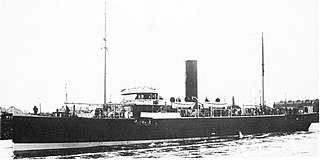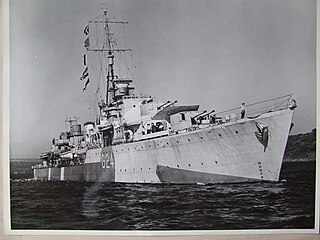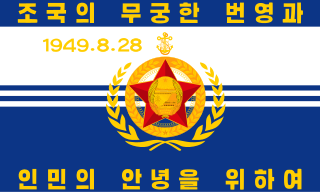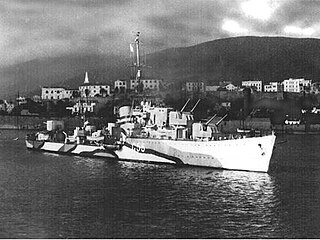
Q-ships, also known as Q-boats, decoy vessels, special service ships, or mystery ships, were heavily armed merchant ships with concealed weaponry, designed to lure submarines into making surface attacks. This gave Q-ships the chance to open fire and sink them.

USS Baltimore (CA-68) was the lead ship of her class of heavy cruiser, the fifth ship of the United States Navy named after the city of Baltimore, Maryland.

HMS Jamaica, a Fiji-class cruiser of the Royal Navy, was named after the island of Jamaica, which was a British Crown Colony when she was built in the late 1930s. The light cruiser spent almost her entire wartime career on Arctic convoy duties, except for a deployment south for the landings in North Africa in November 1942. She participated in the Battle of the Barents Sea in 1942 and the Battle of North Cape in 1943. Jamaica escorted several aircraft carriers in 1944 as they flew off airstrikes that attacked the German battleship Tirpitz in northern Norway. Late in the year she had an extensive refit to prepare her for service with the British Pacific Fleet, but the war ended before she reached the Pacific.

The Battle of the Java Sea was a decisive naval battle of the Pacific campaign of World War II.

USS Maddox (DD-731), was an Allen M. Sumner-class destroyer. It was named after Captain William A. T. Maddox of the United States Marine Corps.

The second USS Juneau (CL-119/CLAA-119) was the lead ship of the United States Navy Juneau-class cruisers.

USS Besugo, a Balao-class submarine, was a ship of the United States Navy in commission from 1944 to 1958. She was named for the besugo.

HMS Ambuscade was an Acasta-class destroyer of the Royal Navy and was launched in 1913. She served throughout the First World War, forming part of the Grand Fleet and taking part at the Battle of Jutland, serving in the Dover Patrol and spending the latter part of the war as a convoy escort. She was sold for scrapping in 1921.

HMCS Huron was a Tribal-class destroyer that served in the Royal Canadian Navy in the Second World War and the Korean War. She was the first ship to bear this name, entering service in 1943. She was named for the Huron people. During the Second World War the vessel saw service in Operation Neptune in the Bay of Biscay and along the French coast in support of the invasion of Normandy and escorted convoys to the Soviet Union. Following the war, the ship was placed in reserve. The destroyer was activated in 1950 as a training ship, but with the onset of the Korean War, was modernized and deployed twice to Korea. Following the war, Huron reverted to a training ship and took part in Cold War-era North Atlantic Treaty Organization (NATO) naval exercises until being paid off for the final time in 1963 and broken up for scrap in 1965.

USS Rowan (DD-782) was a Gearing-class destroyer of the United States Navy, the fourth Navy ship named for Vice Admiral Stephen C. Rowan (1805–1890).

USS Berkeley County (LST-279) was an LST-1-class tank landing ship built for the United States Navy during World War II. Named for counties in South Carolina and West Virginia, she was the only U.S. Naval vessel to bear the name.

The history of the Korean People's Army Naval Force is short compared to most modern navies. It began with the creation of a "Maritime Security Force" on June 5, 1946. The headquarters for the force was based in the North Korean city of Wonsan, and was operational by July 1946. The headquarters were then expanded and moved to the capital, Pyongyang, for more effective management of seabound traffic, and the forces were renamed Marine Patrols in December of the same year. The Marine Patrol Academy was established in Wonsan in June 1947 in order to train and commission a professional corps of naval officers.

HMNZS Hawea (F422), formerly HMS Loch Eck (K422), was one of six Loch-class frigates that served in both the Royal Navy (RN) and the Royal New Zealand Navy (RNZN). The ship was laid down by Smiths Dock on 25 October 1943, launched on 25 April 1944 and commissioned into the Royal Navy as HMS Loch Eck on 7 November 1944.

The Atlantic U-boat campaign of World War I was the prolonged naval conflict between German submarines and the Allied navies in Atlantic waters—the seas around the British Isles, the North Sea and the coast of France.

HMS Lightning was an L-class destroyer of the Royal Navy. She was launched on 22 April 1940 and sunk on 12 March 1943 by German Motor Torpedo Boat S-55.

United States Navy operations during World War I began on April 6, 1917, after the formal declaration of war on the German Empire. The United States Navy focused on countering enemy U-boats in the Atlantic Ocean and the Mediterranean Sea while convoying men and supplies to France and Italy. Because of United States's late entry into the war, her capital ships never engaged the German fleet and few decisive submarine actions occurred.

USS Tutuila (ARG-4) was a Luzon-class internal combustion engine repair ship that saw service in the United States Navy during World War II, The Korean War, and The Vietnam War as well as several smaller actions. Named for the Island of Tutuila, the largest and main island of American Samoa, it was the second US Naval vessel to bear the name. After serving for nearly 30 years Tutuila was sold to the Republic of China in 1972.

The Victorious War Museum, or the Victorious Fatherland Liberation War Museum, is a history/military museum dedicated to the Korean War located in the North Korean capital-city of Pyongyang.

The eighth HMS Worcester, was a Modified W-class destroyer of the British Royal Navy that saw service in World War II. She later served as an accommodation ship as the second HMS Yeoman.




















